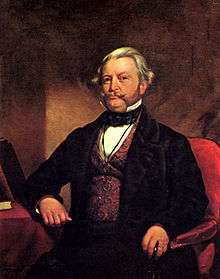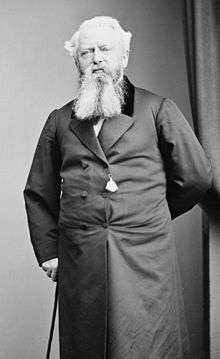Townsend Harris
Townsend Harris (October 4, 1804 – February 25, 1878) was a successful New York City merchant and minor politician, and the first United States Consul General to Japan. He negotiated the "Harris Treaty" between the US and Japan and is credited as the diplomat who first opened Shogunate Japan to foreign trade and culture in the Edo period.
Townsend Harris | |
|---|---|
 Townsend Harris in 1855 (painted by James Bogle) | |
| Born | October 4, 1804 |
| Died | February 25, 1878 (aged 73) New York City, New York, US |

In New York
Harris was born in the village of Sandy Hill (now Hudson Falls), in Washington County in upstate New York. He moved early to New York City, where he became a successful merchant and importer from China.[1]
In 1846 Harris joined the New York City Board of Education, serving as its president until 1848. He was an avid and critical reader and also taught himself French, Italian and Spanish.[1] He founded the Free Academy of the City of New York, which later became the City College of New York, to provide education to the city's working people. A city high school bearing Harris's name, Townsend Harris High School, soon emerged as a separate entity out of the Free Academy's secondary-level curriculum; the school survived until 1942 when Fiorello La Guardia closed it because of budget constraints. Townsend Harris High School was re-created in 1984 as a public magnet school for the humanities.
Commerce
In 1848 he went to California and during the following six years made trading voyages to China and the Dutch and British Indies, becoming thoroughly acquainted with many Asian customs and societies. He acted for a time as American vice-consul at the Chinese treaty port of Ningpo.
Harris Treaty of 1856 with Siam
Harris, though anxious to get to his new post in Japan, went first to Bangkok, to update the 1833 Roberts Treaty. In his formal audience with the English-speaking and Western-oriented Second King, Phra Pin Klao, Harris stated America's position:
The United States does not hold any possessions in the East, nor does it desire any. The form of government forbids the holding of colonies. The United States, therefore, cannot be an object of jealousy to any Eastern Power. Peaceful commercial relations, which give as well as receive benefits, is what the President wishes to establish with Siam, and such is the object of my mission.
Finalization of the Bowring Treaty of 1855 delayed Harris for about a month, but he had only to negotiate minor points to transform it into the Harris Treaty of 1856.[2] Re-designated the Treaty of Amity, Commerce, and Navigation, the amendments granted Americans extraterritorial rights in addition to those in the Roberts Treaty. American missionary Stephen Matoon, who had acted as translator, was appointed the first United States consul to Siam.[3][4][5]
In Japan

President Franklin Pierce named Harris the first Consul General to Tokugawa Japan[6] in July, 1856, where he opened the first US Consulate at the Gyokusen-ji Temple in the city of Shimoda, Shizuoka Prefecture,[7] some time after Commodore Matthew Perry had first opened trade between the US and Japan in 1854.
Harris demanded the courtesies due to an accredited envoy and refused to deliver his president's letter to anyone but the Shogun in Edo, and to him personally. After prolonged negotiations lasting 18 months, Harris finally received a personal audience with the Shogun in the palace. After another four months, he successfully negotiated the Treaty of Amity and Commerce, or the "Harris Treaty of 1858," securing trade between the US and Japan and paving the way for greater Western influence in Japan's economy and politics.[5]
Harris served during the first Japanese Embassy to the United States, during which a false report reached the US of his death.[8] Harris returned home in 1861. Upon his departure, senior Japanese diplomat Moriyama wrote to him "You have been more than a friend. You have been our benefactor and teacher. Your spirit and memory will live forever in the history of Japan."[9]
Harris was favorably impressed by his experiences in Japan at the end of its self-imposed period of isolation. He wrote: "The people all appeared clean and well-fed... well clad and happy looking. It is more like the golden age of simplicity and honesty than I have ever seen in any other country".[10]
According to a persistent legend, Harris adopted a 17-year-old geisha known as Okichi (お吉), whose real name was Kichi Saitou (ja:斎藤きち, Saitou Kichi). The legend has it that she was heavily pressured into the relationship by Japanese authorities and then ostracized after Harris' departure, eventually committing suicide in 1892.[11] However, it appears that Okichi was merely one of Harris' housekeepers,[11] and the Kodansha Encyclopedia states that Harris fired her after just three days of work.[12]
Aftermath
As reported in The New York Times, when he was interviewed in 1874 by the author William Elliot Griffis who had recently returned from Japan, his first question was, "What do the Japanese think of me?"[13] Masao Miyoshi asserts in his book As We Saw Them: The First Japanese Embassy to the United States (1860) that the restrictive lifestyle for Townsend Harris as ambassador in Japan "had forever molded the opener of Japan into a hermit" for the rest of his life while in New York City.[14]
Harris is buried in Green-Wood Cemetery in Brooklyn, New York.[13] In 1986, the nation of Japan presented a gift of a refurbished gravesite including paving stones, a stone lantern, a cherry tree, a dogwood tree, and two commemorative stones, in commemoration of the continuing respect and affection of the Japanese people for Harris.[9]
Townsend Harris and his portrayal in popular culture
Harris was portrayed by John Wayne in the 1958 movie The Barbarian and the Geisha, directed by John Huston. Although the primary plot, dealing with Harris' attempt diplomatically to achieve détente between the U.S. and Japan, is essentially accurate, the subplot dealing with the love affair between Harris and Okichi is substantially fictional[15]
Harris also appears as the main character of several episodes of the satirical Japanese manga-based anime, Gag Manga Biyori as a desperate man with a thick accent attempting to outshine Commodore Perry's arrival in a black-hulled ship in 1853, while making preparations for finalizing the Treaty of Peace and Commerce.
Harris was mentioned by a visiting Japanese dignitary in The Rifleman, in the episode "The Sixteenth Cousin".
Harris is seen in the 47th NHK Taiga Drama Atsuhime. He is played by Blake Crawford. He is also seen in the 52nd NHK Taiga Drama Yae no Sakura.
The Japanese popular song Okichi Monogatari (Okichi's Story) was a hit for Hagoromo Amatsu (ja:天津羽衣, Amatsu Hagoromo) in 1960.
Notes
- Rines, George Edwin, ed. (1920). . Encyclopedia Americana.
- "1b. Harris Treaty of 1856" (exhibition). Royal Gifts from Thailand. National Museum of Natural History. June 21, 2007. Retrieved April 19, 2012.
Credits
- "History of Diplomatic relations between the Kingdom of Thailand (Siam) and the United States of America". Thai American Diplomacy History. Thailand-USA Portal and Hub. Archived from the original on February 12, 2010.CS1 maint: unfit url (link)
- "The Foundations: 1833–1880". United States Embassy, Bangkok. Archived from the original on April 19, 2012.
- Dennett, Tyler (1922). Americans in Eastern Asia: a critical study of United States' policy in the Far East in the nineteenth century, pp. 347–366.
- "Townsend Harris: America's First Consul to Japan" -- biography by the Consulate General of Japan in New York Archived 2007-03-12 at the Wayback Machine
- Japanese Delegation Visits CCNY July 24 2006 to honor founder Townsend Harris: Visit Coincides With 150th Anniversary of Harris' Appointment as First US Consul to Japan Archived 2007-03-11 at the Wayback Machine
- "THE JAPANESE IN PHILADELPHIA". The New York Times. 1860-06-11.
- "The Japan Connection: The 150th Anniversary of Townsend Harris' Arrival in Japan". City College of New York Exhibition Program. Archived from the original on 2010-06-15.
- Quoted in Perrin, p.90
- http://www.cis.doshisha.ac.jp/kkitao/Japan/shimoda/s1.htm%5B%5D
- "Pop Meiji romance revives tired legend of poor Okichi". The Japan Times. Retrieved 23 April 2016.
- Griffis, William. (December 28, 1919). "Townsend Harris, Center of Japanese Drama; Adventures of First American Envoy to Mikado's Empire Furnish the Basis of a Play by a Native Writer, and Tokio Is Applauding the Stars and Stripes", New York Times.
- Miyoshi, Masao. As We Saw Them: The First Japanese Embassy to the United States (1860). University of California Press (1979), p. 173.
- Falk, Ray (January 12, 1958). "Shooting a 'Barbarian'; Townsend Harris Biography Is Filmed At Authentic Japanese Locales", New York Times.
References
- Cosenza, Mario Emilio. (1930). The Complete Journal of Townsend Harris, First American Consul General and Minister to Japan. New York: Doubleday. Reprinted by Kessinger Publishing Company, Whitefish, Montana, 2007. ISBN 978-1-4325-7244-0.
- Dulles, Foster Rhea. Yankees and Samurai: America's Role in the Emergence of Modern Japan, 1791–1900. New York: Harper & Row, 1965.
- Griffis, William Elliot (1895). Townsend Harris, First American Envoy in Japan. New York: Houghton, Mifflin, and Company. A full-text copy of this book.
- Perrin, Noel (1979). Giving up the gun. Boston: David R. Godine. ISBN 0-87923-773-2.
External links
- Selected comments from Harris's conversation with Bakufu Grand Councillor Hotta Masayoshi on December 12, 1857
- "Adrift at Shimoda". Letter from Harris to U.S. Secretary of State Lewis Cass, September 11, 1858.